Pandora Writer |
____________________
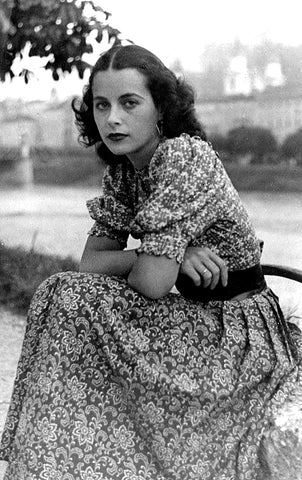 Hedy Lamarr was a talented Austrian-born actress who made a significant contribution to the field of technology. She was born as Hedwig Eva Maria Kiesler on November 9, 1914, in Vienna, Austria. During her childhood, she displayed a strong fascination with math and science. By the age of ten, she had mastered four languages and displayed a remarkable musical talent. By the time she turned 16, she was gracing the silver screen, making her mark in the world of cinema.
Hedy Lamarr was a talented Austrian-born actress who made a significant contribution to the field of technology. She was born as Hedwig Eva Maria Kiesler on November 9, 1914, in Vienna, Austria. During her childhood, she displayed a strong fascination with math and science. By the age of ten, she had mastered four languages and displayed a remarkable musical talent. By the time she turned 16, she was gracing the silver screen, making her mark in the world of cinema.
Her father, Emil Kiesler, was a successful banker, and her mother, Gertrud, encouraged her interest in the performing arts. Her exposure to the cultural scene in Vienna, a city known for its artistic and intellectual vibrancy, played a significant role in shaping her ambitions.
In 1933, she married Fritz Mandl, a wealthy Austrian munitions dealer, who insisted she remain at home as a hostess for his associates. After enduring four years of this marriage, she fled to Paris, where she met Louis Mayer, one of the founders of MGM Studios. Mayer not only brought her to America but also signed her to a movie contract, renaming her Hedy Lamarr.
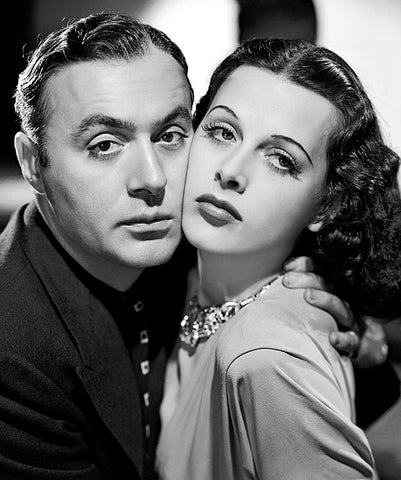 By the late 1930s, Lamarr's career had reached new heights, and Hollywood beckoned. She made her American film debut in the 1938 production "Algiers," starring opposite Charles Boyer. Her striking looks and exotic appeal made her an instant sensation in Hollywood, earning her the nickname "the most beautiful woman in films." Over the next few years, she appeared in a series of successful films, including "Boom Town" in 1940 and "Ziegfeld Girl" in 1941.
By the late 1930s, Lamarr's career had reached new heights, and Hollywood beckoned. She made her American film debut in the 1938 production "Algiers," starring opposite Charles Boyer. Her striking looks and exotic appeal made her an instant sensation in Hollywood, earning her the nickname "the most beautiful woman in films." Over the next few years, she appeared in a series of successful films, including "Boom Town" in 1940 and "Ziegfeld Girl" in 1941.
However, in addition to being a successful actress, Lamarr was deeply interested in science and technology. She became aware of the problems of communication during World War II, and she wanted to create a method to solve them. Thus, she began working on an invention that could help the U.S. Navy protect their communication from enemy detection.
Yet, despite her glamorous Hollywood career, she remained unsatisfied, famously remarking, "Any girl can be glamorous; all she has to do is stand still and look stupid." Her true passion lay elsewhere – in inventing.
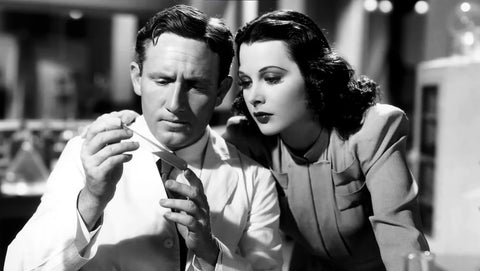 An encounter with Howard Hughes had a profound impact on history. Both shared a passion for science, and Hughes generously provided Lamarr with the tools and equipment needed for her inventive pursuits. During this collaboration, he also gave her an exclusive tour of his aircraft manufacturing facilities. Hughes' support and encouragement played a pivotal role in Lamarr's journey of innovation.
An encounter with Howard Hughes had a profound impact on history. Both shared a passion for science, and Hughes generously provided Lamarr with the tools and equipment needed for her inventive pursuits. During this collaboration, he also gave her an exclusive tour of his aircraft manufacturing facilities. Hughes' support and encouragement played a pivotal role in Lamarr's journey of innovation.
Lamarr collaborated with her friend, composer George Antheil, to develop the technology known as frequency hopping. The technology used a radio signal to hop from one frequency to another, making it almost impossible for enemies to detect and jam the signal. This invention was a breakthrough in communication technology, and it had significant implications for military and commercial use.
 The idea behind frequency hopping was inspired by the unpredictable flight patterns of birds, specifically the way they changed frequencies to avoid collisions. Lamarr and Antheil's invention was granted a patent in 1942, with the official title "Secret Communication System." Although the U.S. Navy expressed interest in their invention, it would take several decades for the true significance of their work to be realized.
The idea behind frequency hopping was inspired by the unpredictable flight patterns of birds, specifically the way they changed frequencies to avoid collisions. Lamarr and Antheil's invention was granted a patent in 1942, with the official title "Secret Communication System." Although the U.S. Navy expressed interest in their invention, it would take several decades for the true significance of their work to be realized.
Despite their groundbreaking invention, Lamarr and Antheil faced skepticism and challenges when trying to get the military to adopt their technology.
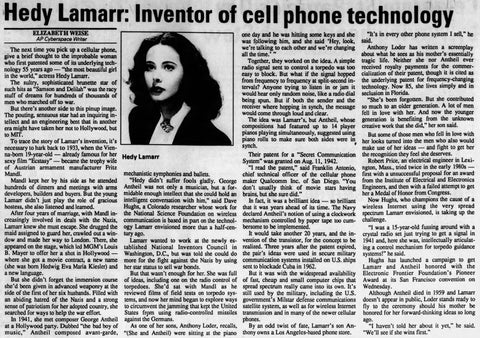 It wasn't until decades later that the significance of Lamarr and Antheil's invention became widely recognized. In the 1950s and 1960s, the concept of frequency hopping technology was implemented in secure military communications, providing a foundation for modern technologies like Bluetooth and Wi-Fi. Lamarr's contribution to technology was finally acknowledged, but it was a recognition that came too late in her life.
It wasn't until decades later that the significance of Lamarr and Antheil's invention became widely recognized. In the 1950s and 1960s, the concept of frequency hopping technology was implemented in secure military communications, providing a foundation for modern technologies like Bluetooth and Wi-Fi. Lamarr's contribution to technology was finally acknowledged, but it was a recognition that came too late in her life.
As Lamarr's acting career began to wane in the 1950s, she shifted her focus to other pursuits. She had been married and divorced six times, and her personal life had its share of trials and tribulations. She dabbled in various business ventures and even authored an autobiography, which provided a candid look at her life in Hollywood.
 In the 1990s, Hedy Lamarr's contributions to technology finally received the acknowledgment they deserved. She was honored with various awards and accolades, including the Electronic Frontier Foundation Pioneer Award in 1997 and induction into the National Inventors Hall of Fame in 2014, posthumously.
In the 1990s, Hedy Lamarr's contributions to technology finally received the acknowledgment they deserved. She was honored with various awards and accolades, including the Electronic Frontier Foundation Pioneer Award in 1997 and induction into the National Inventors Hall of Fame in 2014, posthumously.
Hedy Lamarr's legacy extends far beyond her glamorous Hollywood image. Her invention of frequency hopping technology laid the groundwork for secure wireless communication, revolutionizing the way we communicate in the modern world. Bluetooth, Wi-Fi, and many other wireless technologies owe a debt of gratitude to Lamarr's pioneering work.
While she may have been overlooked during her lifetime, Hedy Lamarr's contributions to technology have left a permanent mark on the world. Lamarr passed away on January 19, 2000, leaving behind a legacy that celebrated both her cinematic prowess and her groundbreaking contributions to the field of invention.
-----------------------------------------------------------------------------------------------------------
Did you know?
 Hedy Lamarr produced some of her own movies. She produced "The Strange Woman" in 1946, in which she also starred, and "Dishonored Lady" in 1947.
Hedy Lamarr produced some of her own movies. She produced "The Strange Woman" in 1946, in which she also starred, and "Dishonored Lady" in 1947.
The most intriguing fact about Hedy Lamarr is her role in the development of frequency hopping technology, which laid the foundation for modern wireless communication systems like Bluetooth and Wi-Fi. Her invention was ahead of its time and revolutionized secure communication.
Lamarr was not just a talented actress and inventor; she was also multilingual. She could speak several languages fluently, including German, English, and French, which undoubtedly contributed to her success in the international film industry.
In addition to her groundbreaking work in communication technology, Lamarr co-invented a radio-controlled glider in the early 1940s, which was intended for military use as a flying bomb.
 She was married to Friedrich Mandl, an Austrian arms manufacturer, before her Hollywood career took off. It is said that Mandl's discussions about military technology and weapons during their marriage piqued her interest in science and technology.
She was married to Friedrich Mandl, an Austrian arms manufacturer, before her Hollywood career took off. It is said that Mandl's discussions about military technology and weapons during their marriage piqued her interest in science and technology.
Lamarr and George Antheil, her co-inventor, submitted a patent application for their frequency hopping invention during World War II. The patent was granted in 1942 but went unnoticed at the time due to its classified nature.
During her experiments with frequency hopping, Lamarr and Antheil also envisioned a substance they called "radio frequency glue." This was meant to help torpedoes adhere to their targets, but the technology was never fully implemented.
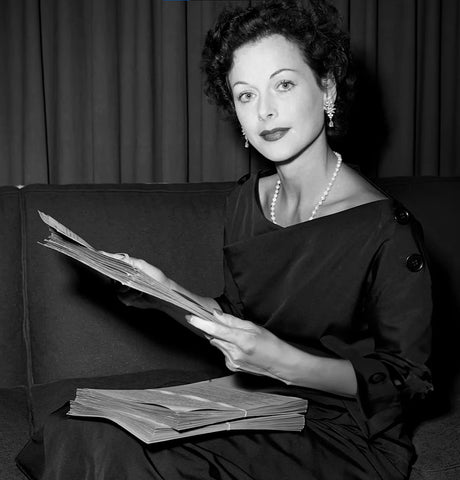 Despite her fame and contributions, Lamarr lived an anonymous life in her later years. She was often out of the public eye and struggled financially. It wasn't until the 1990s that she received widespread recognition for her technological achievements.
Despite her fame and contributions, Lamarr lived an anonymous life in her later years. She was often out of the public eye and struggled financially. It wasn't until the 1990s that she received widespread recognition for her technological achievements.
Over the course of her life, the talented actress experienced six marriages and divorces while also raising three children.
On February 8, 1960, she received a coveted Hollywood Walk of Fame Star, which was placed at 6247 Hollywood Blvd.
In 2022, Jeff Beck and Johnny Depp released a song titled “This Is A Song For Miss Hedy Lamarr.” The song was released before Jeff Beck passed away on January 10, 2023.
Hedy Lamarr continues to inspire many, particularly women in STEM fields. Her story serves as a powerful reminder that anyone, regardless of their background or profession, can make significant contributions to science and technology.
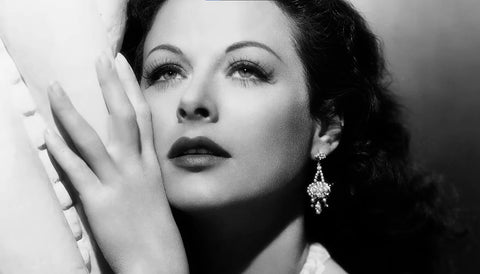 Hedy Lamarr's patent can be viewed on the National Archives Pieces of History blog or at the National Air and Space Museum website. (Patent Case File No. 2,292,387, Secret Communication System, Inventors Hedy Kiesler Markey and George Antheil).
Hedy Lamarr's patent can be viewed on the National Archives Pieces of History blog or at the National Air and Space Museum website. (Patent Case File No. 2,292,387, Secret Communication System, Inventors Hedy Kiesler Markey and George Antheil).
"I was madly in love with life." – Hedy Lamarr
